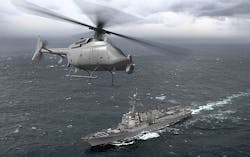Navy asks Northrop Grumman to build five long-range Fire Scout UAVs in $43.8 million contract
Officials of the Naval Air Systems Command at Patuxent River Naval Air Station, Md., are asking the Northrop Grumman (NYSE:NOC) Aerospace Systems segment in San Diego to build five MQ-8C Fire Scout vertical take-off and landing tactical unmanned aerial vehicles (VTUAV), which are based on the manned Bell 407 helicopter from Bell Helicopter Textron Inc. in Fort Worth, Texas.
The manned version of the Bell 407 seats seven, can carry a useful load of 2,347 pounds, flies as fast as 140 knots, and has a range of 324 nautical miles.
The MQ-8A and MQ-8B versions of the Navy Northrop Grumman Fire Scout UAV are based on the Schweizer 333 helicopter from Schweizer Aircraft Corp., a Sikorsky Aircraft company based in Horseheads, N.Y. Schweizer Aircraft now is doing business as the Sikorsky Military Completions Center (SMCC).
Related: Next-generation Fire Scout unmanned helicopters to have increased range and payload
The commercial version of the Schweizer 333 seats three, can carry a payload of 1,250 pounds, can fly as fast as 105 knots, and has a maximum range of 319 nautical miles.
Military leaders in 2011 said they needed a shipboard UAV by the start of this year to provide 24-hour intelligence, surveillance, and reconnaissance (ISR) continuous coverage out to a range of 150 nautical miles, which required a longer-range version of the Fire Scout unmanned helicopter.
(story continues below)
The MQ-8B is limited to operating for only eight to 12 hours per day of ISR coverage at a range of only 100 nautical miles, Navy officials say. To meet the longer-range requirements, Northrop Grumman experts will use the avionics developed for the MQ-8B, as well as the software and ground-control systems, on the longer-range MQ-8C based on the Bell 407.
The MQ-8C will provide the Navy with an increased range of more than 30 percent, twice the endurance, and an increased payload capacity over the existing MQ-8B variant, Northrop Grumman officials say. The unmanned systems architecture developed for the MQ-8B is re-used in the Bell 407.
Related: Navy chooses shipboard UAV data-control links from L3 Communications-West UAVs
The primary advantage of the MQ-8C Fire Scout over its MQ-8B and MQ-8A versions is the newest shipboard UAV has double the useful payload of its predecessors. The newest model also has a somewhat faster top speed and slightly more maximum range than previous models of the Fire Scout.
Manufacturing and assembly operations of the new Fire Scout variant are at Bell's facility in Ozark, Ala., and final assembly is Northrop Grumman's Unmanned Systems Center in Moss Point, Miss.
Related: Navy issues urgent order to equip MQ-8 helicopter UAV with maritime surveillance radar
On the contract awarded Wednesday, Northrop Grumman will do the work in Dallas; Ozark, Ala.; Rancho Bernardo, Calif.; Moss Point, Miss.; and Point Mugu, Calif., and should be finished in December 2015.
For more information contact Northrop Grumman Aerospace Systems online at www.northropgrumman.com, Bell Helicopter Textron at www.bellhelicopter.com, or the Sikorsky Military Completions Center at www.sacusa.com.
